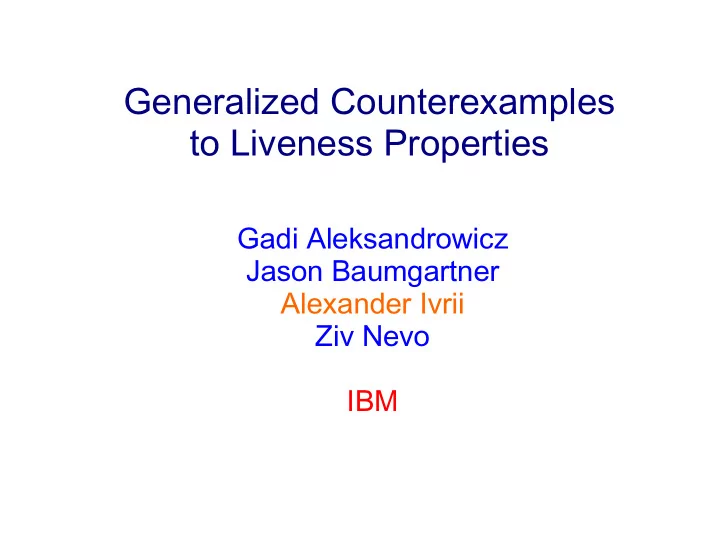

Generalized Counterexamples to Liveness Properties Gadi Aleksandrowicz Jason Baumgartner Alexander Ivrii Ziv Nevo IBM
Outline � Generalized counterexamples to liveness – and why they are especially interesting � How to detect that a trace exhibits a liveness CEX – and how to manipulate traces to increase this likelihood � k-LIVENESS with failure detection � Conclusions 2
Liveness Properties � Reduce to the form FGq (with q a state variable) � FGq passes: – on every trace q eventually becomes true forever … � FGq fails: there is a trace on which � q holds infinitely often – … equivalently, there is a finite trace with a repeating state, and � q in-between – repetition � � q � � s s q q q 3
Example � (q, x, y) – state variables – initially: q = 1, x = 0, y = 0 q’ = (q � x) � ( � q � y), x’ = q � y, y’ = � x – next-state: � There is a concrete counterexample to FGq of length 4: repetition (1, 0, 0) � (0, 0, 1) � (1, 0, 1) � (0, 1, 1) � (1, 0, 0) – � There is a “generalized” counterexample to FGq of length 2: repetition (1, 0, � ) � (0, � , 1) � (1, 0, � ) – 4
Generalized CEXes � generalized state: a partial assignment to state variables � s is a generalized predecessor of t: for every state in s, there is a transition to some state t � t 0 , t 1 , …, t n generalized trace: – t 0 contains a state in Init t i is a generalized predecessor of t i+1 for every i, 0 � i < n – � generalized counterexample to FGq: – a generalized trace t 0 , t 1 , …, t n t m � t n for some 0 � m < n – (“closing” the generalized loop) t k � � q for some m � k � n (detecting violation of q) – t n is more concrete t m t k t n 5
Observations � The existence of a generalized liveness CEX always implies the existence of a concrete CEX � A generalized liveness CEX can be exponentially shorter than a concrete CEX � Makes sense to develop algorithms that search for generalized counterexamples – In the paper we suggest a BMC-like algorithm based on 3-valued netlist encoding 6
k-LIVENESS � Reference: “A Liveness Checking Algorithm that Counts”, FMCAD’12 [Claessen-Sörensson] A safety query of the form “is there a trace on which � q occurs at least k � times” is passed to a model checker � If there is no such trace for some k, FGq passes � Does not detect whether FGq fails 7
Extending k-LIVENESS � Analyze counterexample traces � q occurs at least k times – – somewhat generalized - if implemented on top of PDR If there are states t m , t n , t k with m < k � n so that t m � t n and t k � � q then � FGq fails. Both checks are purely syntactic (very fast). � Detects failure of FGq on 44 HWMCC’12 liveness benchmarks (with small values of k) � On 2 benchmarks performs significantly better than BMC 8
Example � (q, x, y) – state variables – initially: q = 1, x = 0, y = 0 q’ = q � x, x’ = x, y’ = � y – next-state: � Consider traces of length 2: (1, 0, 0) � (0, 0, 1) � (0, 0, 0) – concrete: not a CEX (1, 0, � ) � (0, 0, � ) � (0, 0, � ) – generalized: CEX (1, 0, � ) � (0, 0, � ) � (0, � , � ) – generalized more: not a CEX Generalizing traces may create or destroy liveness CEXes 9
Manipulating Traces � Generalization (“backwards”) – If s is a predecessor of t, sometimes can remove variables from s � Concretization (“forward”) – If s is a predecessor of t, sometimes can add variables to t � ConcretizeTentative (“try to close the loop”) – If t i and t j have no variables in opposite polarities (i<j), concretize from t i towards t j 10
Concluding remarks � Generalized counterexamples to liveness can be significantly shorter than concrete counterexamples � It makes sense to search for generalized counterexamples directly � k-LIVENESS can be easily extended with failure detection � Traces may be manipulated to increase the chance of detecting a counterexample 11
Thank You! 12
Recommend
More recommend